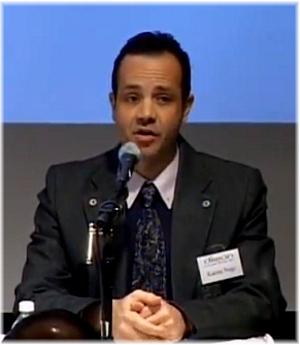Arab Identity and the Arts: Diaspora and Outreach.
Karim Nagi
March 31, 2016, 3:00PM
Phelp Stokes
Berea College Convocation
Co-sponsored with the Francis and Louise Hutchins Center for International Education.

Karim Nagi, musician, performer and orator, shows how Arabs can be misunderstood in the U.S. and how the arts can help familiarize people with Arab culture. Through his interactive and performance-based presentation, Nagi provides examples of Arab music and dance to educate and enthrall non-Arab audiences.

Karim Nagi is a native Egyptian drummer, DJ, composer and folk dancer. He is the creator of Turbo Tabla , and has released four internationally distributed CDs of this unique brand of Arab House/Electronica using acoustic instruments. Karim has authored instructional DVDs for the Tabla/Doumbek, Riqq tambourine, Maqam & Taqsim, Drum Solo for Dance, and Arab Folk Dance.

He is well versed in the ultra-traditional styles of music, and has lead the Sharq Arabic Music Ensemble since 1999. He promotes and fosters the study of Arab dance in the USA as the director of the Arab Dance Seminar. Karim performs and teaches Tahteeb Cane Dance, Dabka Line Dance, and Zikr Sufi Dance.
Come check out our book display and these items listed below!

Music and Media in the Arab World by Michael Frishkopf (Editor)
Call Number: E-Book
ISBN: 1617976032
Since the turn of the twentieth century the dramatic rise of mass media has profoundly transformed music practices in the Arab world. Music has adapted to successive forms of media dissemination--from phonograph cylinders to MP3s--each subjected to the political and economic forces of its particular era and region. Carried by mass media, the broader culture of Arab music has been thoroughly transformed as well. Simultaneously, mass mediated music has become a powerful social force. While parallel processes have unfolded worldwide, their implications in the Arabic-speaking world have thus far received little scholarly attention.This provocative volume features sixteen new essays examining these issues, especially televised music and the controversial new genre of the music video. Perceptive voices--both emerging and established--represent a wide variety of academic disciplines. Incisive essays by Egyptian critics display the textures of public Arabic discourse to an English readership. Authors address the key issues of contemporary Arab society--gender and sexuality, Islam, class, economy, power, and nation--as refracted through the culture of mediated music. Interconnected by a web of recurrent concepts, this collection transcends music to become an important resource for the study of contemporary Arab society and culture.Contributors: Wael Abdel Fattah, Yasser Abdel-Latif, Moataz Abdel Aziz, Tamim Al-Barghouti, Mounir Al Wassimi, Walter Armbrust, Elisabeth Cestor, Hani Darwish, Walid El Khachab, Abdel-Wahab Elmessiri, James Grippo, Patricia Kubala, Katherine Meizel, Zein Nassar, Ibrahim Saleh, Laith Ulaby.

Modern Arab Art by Nada M. Shabout
Call Number: 709.174 S524m 2007 - Circulating (3rd Floor)
ISBN: 0813031508
"Groundbreaking. Shabout elucidates two critical issues that have thus far received inadequate scholarly attention--the distinction between Islamic Art and Arab Art and the relatedness of the political and artistic processes in the history of Arab modernity."--Shiva Balaghi, coeditor of Picturing Iran: Art, Society and Revolution "One of the first publications to consider the various cultural and social conditions that have helped shape Modern Arab Art as a recent phenomenon linked to the rise of Arab identity, the impact of western art training, and a search for a contemporary language which links with Islamic art but is discontinuous with it."--Fran Lloyd, Kingston University "Art is one way to visualize the interconnectedness of people and this book shows us how related in influence and aspirations we all are."--Linnea S. Hedrick, Miami University Modern Arab Art provides a historical and theoretical overview of the subject from the 1940s through today. With particular emphasis on production, reception, and the intersection between art and politics in Iraq and Palestine, Nada Shabout reveals the fallacy in Western fascination with Arab art as a timeless and exotic "other."
The Arab World by Halim I. Barakat
Call Number: 909.097 B224a - Circulating (3rd Floor)
ISBN: 0520079078
This wide-ranging examination of Arab society and culture offers a unique opportunity to know the Arab world from an Arab point of view. Halim Barakat, an expatriate Syrian who is both a scholar and a novelist, emphasizes the dynamic changes and diverse patterns that have characterized the Middle East since the mid-19th century. His is a picture that differs dramatically from the static one portrayed by much of Western scholarship. Barakat maintains that the unequal power relationships between Western imperial forces and Arabs have strongly influenced Western writing, thereby limiting our understanding of what it means to be Arab.




Commenting on blog posts requires an account.
Login is required to interact with this comment. Please and try again.
If you do not have an account, Register Now.